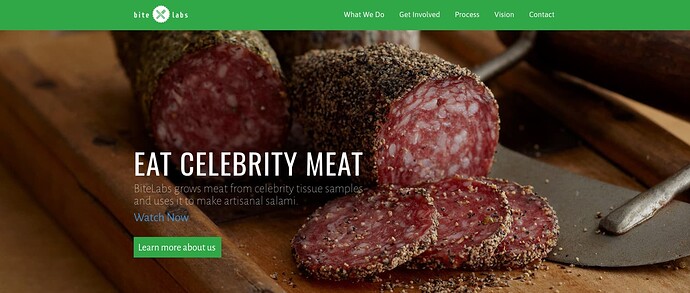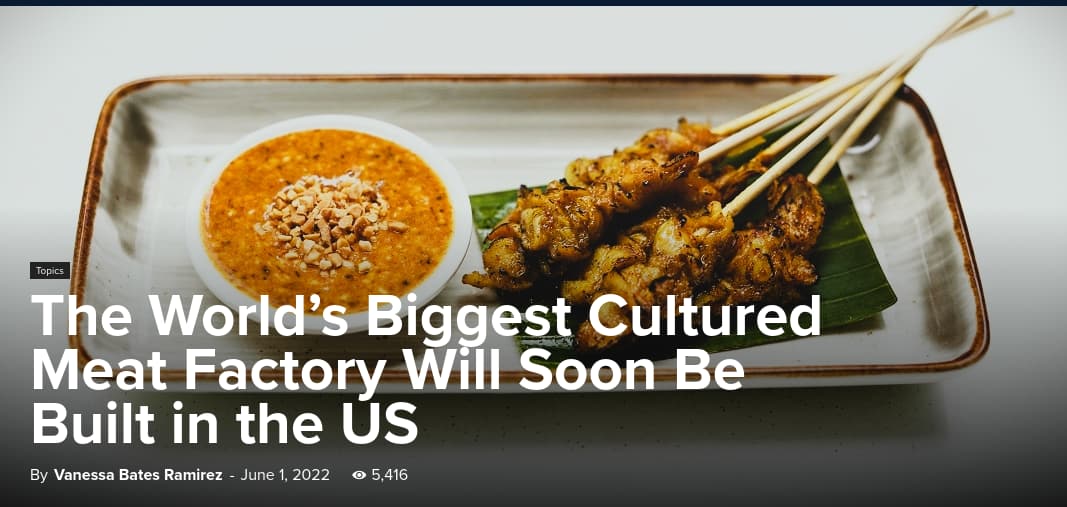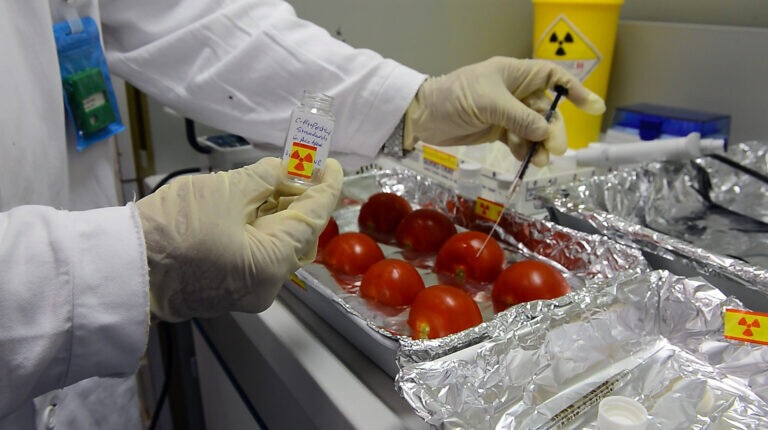Good compilation video; great wake-up call to share. Thank-you.
You're welcome.
There's no real way to know what is in hamburger unless you give the butcher a roast to grind up to order.
You cannot trust or believe the percentage of fat labeled on the package or even if there are remnants of other animals due to either not properly cleaning the machine or straight up adding fillers.
Yes, agreed. Nearly the entire consumer food supply is rigged, it's sickening.
Farm-raised salmon is the first one listed in this video.
Surely, we here wouldn't eat most (hopefully none) of this stuff anyway. Some, in this video is repeated from the last one I posted, but at least it's a living soul speaking, who is a Godly man.
Major Brands Quietly Slipping Insects Into Your Food
Major companies are quietly adding insects to their food products, implementing a goal established by the World Economic Forum that seeks to have humans eat bugs as one of its purported keys to a sustainable planet.
On Sunday, carnivore diet guru Dr. Shawn Baker tweeted a photo of a bag of cheddar cheese puffs, only instead of being made of corn meal these snack foods were chock-full of insect protein.
Video in link above:
WEF You Will Eat Bugs and Be Happy
Lab-Meat to Hit U.S. Grocery Shelves by 2022, After Quiet Approval by FDA and USDA
World’s first lab-grown meat facility says it will begin shipping “animal-free” meat to the U.S. next year.
Instead of being raised on a farm or ranch, your meat could soon be grown in petri-dishes in a high-tech laboratory.
An Israeli company called Future Meat Technologies has built its first lab-grown meat plant, in which it plans to use bioreactors to churn out cell-cultured meat for American restaurants.
The company, which is in talks with the FDA and USDA, plans to begin shipping the test-tube meat to the United States by the end of 2022, Bloomberg reports.
Also known as cellular meat, production of the product involves retrieving stem cells from a live animal’s muscles and then “culturing” them in a nutrient-rich liquid.
The clusters of multiplying cells grow around a “scaffold,” which helps the tissue take on a desired shape — nuggets or patties, for example.
“The result is a product that looks and tastes like meat because it’s made from animal cells, rather than plant-based products,” the industry boasts.
The FDA and USDA quietly gave lab meat the green light back in 2018.
In a press release, the agencies announced that the FDA would oversee “cell collection, cell banks, and cell growth and differentiation,” while the USDA would oversee the production and labeling of the “poultry and livestock” products.
Tyson and Cargill are the **top two investors **in lab-grown animal protein technology so far.
The American Meat Science Association worries that lab-grown protein is not as safe or nutritious as traditional meat.
Just under a year ago, one of the biggest production facilities for cultured meat opened in Israel. Future Meat Technologies’ Rehovot plant produces 500 kilograms of lab-grown meat per day (that’s equivalent to about 5,000 burger patties). Last week, plans for an even bigger facility were revealed, this one in the US. Its specific location has yet to be finalized, but the project will bring cultured meat production to an unprecedented scale.
The bioreactors planned for the US facility will be over 40 feet tall and will hold 250,000 liters (that’s 66,043 gallons) of meat. This is a massive scale-up from existing technology; the same manufacturer that’s making the US equipment, ABEC, is also making a 6,000-liter bioreactor for a facility in Singapore, and when it goes online in 2023 it will be the biggest of its kind installed to date. Multiplying that by more than a factor of 40, then—and making sure the quality of the final product is still the same—will be no small feat.
The company behind the project is California-based Good Meat. Though the company has been selling its lab-grown chicken in Singapore since 2020, it’s still awaiting FDA approval to sell its products in the US. That’s not stopping it from going ahead with the ambitious plans for the new facility, though.
“The bioreactors will be far and away the largest, not only in the cultivated meat industry, but in the biopharma industry too,” said Josh Tetrick, CEO of Good Meat’s parent company, Eat Just. “So the design and engineering challenges are significant, the capital investments are significant, and the potential to take another step toward shifting society away from slaughtered meat is significant.”
Cultured meat—not to be confused with plant-based meat—is grown from animal cells and is biologically the same as meat that comes from an animal. The process starts with harvesting muscle cells from an animal, then feeding those cells a mixture of nutrients and naturally-occurring growth factors (or, as Good Meat’s process specifies, amino acids, fats, and vitamins) so that they multiply, differentiate, then grow to form muscle tissue—in much the same way muscle grows inside animals’ bodies.
According to Good Meat’s website, they use cells from only “the best” chickens and cows (what makes them the best isn’t spelled out), and carefully choose cells most likely to produce flavorful, sustainable meat. Besides being used as starters to grow edible meat in bioreactors, the cells are also “immortalized,” growing and dividing over and over; cells from one chicken could end up producing thousands of breasts.
“Cultivated meat matters because it will enable us to eat meat without all the harm, without bulldozing forests, without the need to slaughter an animal, without the need to use antibiotics, without accelerating zoonotic diseases,” Tetrick said.
Meat can be “harvested” (their word, not mine) just four to six weeks after initiating the growth process—but it’s not a matter of plucking a ready-to-package breast from a vat and shipping it off to the grocery store. Besides going through safety and regulatory reviews, the harvested cells need to be turned into something resembling traditional meat. Good Meat says it uses 3D printing, extrusion cooking, and molding to refine the shape and texture of the product.
This all starts to sound a little Franken-meaty, but the company emphasizes that its products have nutritional profiles identical to those of conventionally-raised meat. A few of the “final formats” the meat comes in include chicken nugget bites, sausages, shredded chicken, and chicken breasts.
It’s going to take a long time for factory farming to stop being a thing, but as cultured meat continues to become more scalable, that day could be on the horizon. Tetrick thinks it’ll happen within his generation’s lifetime. “I think our grandchildren are going to ask us about why we ate meat from slaughtered animals back in 2022,” he said.
Good Meat is expected to finalize the location of its US plant before summer’s end, and they’re aiming for domestic production to start by late 2024.
World's first lab-grown-meat factory opens in Israel
By Nick Lavars
June 24, 2021

Future Meat Technologies is rapidly reducing the cost of its lab-grown chicken
Future Meat Technologies
From Singapore to the International Space Station, we're starting to see how cultured, or lab-grown, meat might soon make its way out of the lab and into everyday diets, and a newly opened factory in Israel should do plenty to help things along. Billed as the world's first industrial production facility for cultured meat, local company Future Meat Technologies sees it as a key stepping stone in efforts to scale up its operations.
The technology behind lab-grown meat has come along in leaps and bounds in recent times, progressing from early "soggy forms of pork" produced around a decade ago, to complex, thick-cut rib-eye steaks in 2021. Most follow one of two methodologies, either using plant products as their starting point, like the beef and pork offered by startup Impossible Foods, or beginning with real cells harvested from live animals.
These cells are nurtured carefully in bioreactors and fed the same nutrients as the living animals, enabling the cells to grow and multiply until they develop into edible cuts of meat. The many startups racing to commercialize this technology all vary slightly in their approaches, but all hope to provide a solution to the environmental and ethical issues that cloud modern meat production.
Future Meat Technologies falls in this latter group, turning animal cells into edible portions using its own proprietary method. This involves no genetic modification and includes what the company calls a "media rejuvenation process," which removes waste products more efficiently and apparently leads to yields 10 times higher than the industry standard. It says its process also generates 80 percent less greenhouse gas emissions, uses 99 percent less land and 96 percent less freshwater than typical meat production.
Future Meat Technologies opened a production facility for lab-grown meat in Rehovot, Israel earlier this year
Future Meat Technologies
The company will put this technique to the test on its largest scale yet, cutting the ribbon on its new cultured meat facility in the Israeli city of Rehovot. The factory will have the capacity to produce 500 kg (1,100 lb) of cultured chicken, pork and lamb each day, which is equivalent to around 5,000 burgers, and the company says beef products are on the way. For reference, about 4.7 lb (2.1 kg) of meat is harvested from each chicken in the US, so the facility's daily output is equal to around 250 chickens.
The first lab-grown burgers cost more than US$300,000 apiece to produce back in 2013. Bit by bit, however, we're seeing progress in driving these costs down to the point where mainstream outfits like KFC are getting in on the action. Future Meat Technologies says it is the only company to be able to produce cultured chicken breasts for $3.90 a pop and, as it continues to scale up its operations, it expects those costs to fall even further.
"After demonstrating that cultured meat can reach cost parity faster than the market anticipated, this production facility is the real game-changer," says Yaakov Nahmias, founder and chief scientific officer of Future Meat Technologies. "This facility demonstrates our proprietary media rejuvenation technology in scale, allowing us to reach production densities 10-times higher than the industrial standard. Our goal is to make cultured meat affordable for everyone, while ensuring we produce delicious food that is both healthy and sustainable, helping to secure the future of coming generations."
NUCLEAR/ Radiation POISONING
Peaceful Uses of Nuclear Technology: A Powerful Tool for a Better World
An IAEA Fellow trained in food quality testing uses nuclear-derived techniques at the joint Food and Agricultural Organization of the UN/IAEA Food and Environmental Protection Laboratory in Seibersdorf, Austria. (Photo: IAEA)
The International Atomic Energy Agency (IAEA) is a key facilitator in the development and delivery of the peaceful uses of nuclear energy and technology. The United States is by far the largest contributor to IAEA peaceful use programs, providing more than $395 million since 2015, including more than $93 million to its Peaceful Uses Initiative (PUI), established in 2010 to attract additional funding and support projects that expand and complement the IAEA’s technical assistance activities.
Contributions to the Peaceful Uses Initiative have enhanced the capabilities of more than 150 IAEA Member States to promote human health, water resource management, food security, sustainable development, and clean energy while responding to emerging and unanticipated needs.
Nuclear technology plays a pivotal role in addressing the world’s energy, health, and agricultural needs. Nuclear innovation is also a key tool used to support the UN Sustainable Development Goals — a series of 17 global objectives established as a “blueprint” for a more sustainable future. Since the UN’s announcement of the Sustainable Development Goals in 2015, the IAEA has made use of the resources provided by the Peaceful Uses Initiative to target critical development needs globally.
Listed below are a few of the UN Sustainable Development Goals that U.S. contributions to the Peaceful Uses Initiative (PIU) have supported:
Sustainable Development Goal #2: Ensuring Food Security
In Africa, U.S. contributions of $23 million in support of the PUI have helped fund laboratories to improve the detection and eradication of livestock diseases like the peste des petit ruminants — also known as sheep and goat plague. U.S. contributions to the PUI have also helped ensure food quality, crop yields, and reduced insect threats to agriculture. PUI funds supported a project that targeted the tsetse fly in Senegal, reducing the destructive fly population and improving farmers’ livelihoods.
Access to clean water is under threat in many parts of the world due to pollution, overuse, and climate change. Scientists use nuclear and isotopic techniques to find, study, and protect water resources. Additionally, irradiation with electron beams can destroy certain pollutants from wastewater generated from industrial processes.
Beyond Meat factory is beyond gross, leaked docs allege
Photos and internal documents leaked by former employees of the Philadelphia-area plant which manufactures the plant-based meat substitute show what appear to be spills, unsafe use of equipment, and mold on walls and ingredient containers.
Documents obtained by Bloomberg's former staff and first published on Monday indicate that Beyond Meat products manufactured in the Pennsylvania plant contained contaminants and foreign objects, including string, metal, plastic, and wood.
But if you have ever tried Beyond Meat, would you know the difference?
This is the second scandal to hit the fake meat company in recent months. Former Beyond Meat COO Doug Ramsey was suspended in September after a road rage incident in a parking lot in which he bit a man's nose off.
Despite an intensive celebrity-driven marketing campaign, shares of Beyond Meat have declined 80% since January as demand for fake meat plummets.
An unprecedented move by the U.S. Food and Drug Administration last week could change how we consume meat.
"The fact that the FDA green-lit Upside Foods' cultivated chicken to move forward to coming to market is something that's never happened in the history of humanity," said Uma Valeti, CEO and co-founder of Upside Foods.
Upside Foods is a California-based company behind the first lab-grown meat to receive FDA clearance, bringing it a step closer to U.S. grocery stores and restaurants.
Valeti, a cardiologist who worked at the Mayo Clinic, says he stopped eating meat in medical school when he saw the detriment of mass meat production, but then he saw an opportunity for a slaughter-free option.
"During my work in cardiology, we were working with stem cells and injecting them into patients' hearts to regrow the heart muscle and that's where this idea came from - ‘can you grow meat directly from animal cells?’ And if so, what would that mean to the world?" (Full article.)
Reading the headlines and press releases on this action by the FDA, one is led to believe that the FDA has approved this lab-grown "chicken."
But the FDA doesn't approve foods. They monitor food safety and labeling, but they do not approve foods. They only approve drugs.
Here is the actual press release from the FDA:
FDA Completes First Pre-Market Consultation for Human Food Made Using Animal Cell Culture Technology
The U.S. Food and Drug Administration (FDA) completed its first pre-market consultation for a human food made from cultured animal cells. We evaluated the information UPSIDE Foods submitted to the agency and have no further questions at this time about the firm’s safety conclusion. The firm will use animal cell culture technology to take living cells from chickens and grow the cells in a controlled environment to make the cultured animal cell food.
The FDA's pre-market consultation with the firm included an evaluation of the firm’s production process and the cultured cell material made by the production process, including the establishment of cell lines and cell banks, manufacturing controls, and all components and inputs. The voluntary pre-market consultation is not an approval process. Instead, it means that after our careful evaluation of the data and information shared by the firm, we have no further questions at this time about the firm’s safety conclusion.
And who are the investors that are bringing this product to market?
Investors include top meat producer Tyson, Bill Gates, Richard Branson, and Elon Musks' brother Kimbal Musk. (Source.)
Now there's a bunch of names we can certainly trust to look out for our health!
Google Just Killed Burger King's Newest TV Ad That Had A Disastrous Flaw
Burger King's new ad encourages people to ask Google Home to say what a Whopper is. The problem is that people can edit the Wikipedia page.

Google Just Killed Burger Kings Newest TV Ad That Had A Disastrous Flaw
24 Popular Chocolate Brands Whose Products Contain Heavy Metals Lead and Cadmium
While there are many benefits associated with eating chocolate, it’s hard to say whether you’d be getting the same benefits if your chocolate was tainted with toxic heavy metals lead and cadmium.
Unfortunately, this is the case for many popular brands we see on the market today (even “organic” brands). In fact, a great deal of the chocolate consumed around the world contains lead and cadmium, two heavy metals that are toxic to the body.
Negative Health Effects of Lead and Cadmium
In a study conducted by As You Sow, levels of cadmium and lead in 45 of 70 chocolate bar samples (including some organic brands) tested were found to be higher than what is considered safe in drinking water.
Both lead and cadmium are toxic metals that are unhealthy even at extremely low doses.
Lead is found in many places in our environment: air and drinking water, soil, dust, paint, cosmetics, contaminated herbal products from China, children’s toys, jewelry, ceramics, imported canned food, and many other sources (including chocolate).
Lead is toxic to the nervous system, liver, kidneys and reproductive system. Chronic exposure can lead to anemia, weakness, kidney damage, and even brain damage (1). “Lead exposure is associated with neurological impairment, such as learning disabilities and decreased IQ, even at very low levels. In fact, there is no safe level of lead for children,” said Eleanne van Vliet, MPH, As You Sow’s Environmental Health Consultant.
“As underscored by the Flint disaster, humans have contaminated our environment with lead, and now we must do everything in our power to protect ourselves and children, who are the most vulnerable of us, from every possible exposure,” said Sean Palfrey, MD, a paediatrician and Professor of Paediatrics and Public Health at Boston University School of Medicine.”Young children and pregnant women especially should avoid exposure to lead.”
Cadmium isn’t much better. Chronic exposure to cadmium can create serious problems in the kidneys, bones, and lungs, leading to conditions such as osteoporosis, heart disease and even cancer (2). As with lead, children are more susceptible to the ill-effects that long-term low doses of cadmium can have on the body over time.
“Lead and cadmium accumulate in the body, so avoiding exposure is important, especially for children,” explained Danielle Fugere, As You Sow President. “Our goal is to work with chocolate manufacturers to find ways to avoid these metals in their products.”
Why Are Heavy Metals Found In Chocolate?
One word: contamination.
While manufacturers claim that lead and cadmium are absorbed by the cacao plant in trace amounts and come from naturally-occurring sources, research claims otherwise.
An article published in Environmental Health Perspectives looked at the studies done by American, Nigerian, British, and Australian researchers. They concluded that only a small percentage of contamination is coming from the soil itself. The big contributor? The shipping and processing of cocoa products (3).
Another study published by As You Sow (the same people who conducted the heavy metals in chocolate study), found that lead and cadmium contaminate chocolate via the following routes (4):
– Soil contamination due to man-made pollution
– Direct application of pesticides and sewage sludge disposal containing lead and cadmium, as well as fertilizers containing cadmium
– Processing: fermentation, drying the beans, manufacturing (drying, refining, cinching), shipping, handling, packaging
According to As You Sow, the largest contributor to heavy metal contamination in chocolate occurs after the beans have already been harvested and dried. Shipment and manufacturing of cocoa and chocolate products is also a major contributor (5).
In the U.S., there is no set limit for these metals in chocolate, aside from California, where chocolate makers are required to put a warning label on their products if they contain more than 4.1 mg of cadmium per daily serving.
This is unlike the European Union, who has developed strict guidelines for cadmium exposure: no more than 0.10 mg/kg of cadmium in milk chocolate, and no more than 0.30 mg/kg of cadmium for darker chocolates.
A recent review published in 2019 pointed out a variety of different studies that looked into heavy metal concentrations in cacao and cocoa products (6).
One of the studies looked at in the review explained that processing methods accounted for increased concentration of heavy metals.
This also explains why milk chocolate might show up as having lower levels of heavy metals, as the percentage of cocoa powder in chocolate products is directly proportional to their corresponding lead and cadmium levels (7).
In addition, some studies have found that cadmium concentration in cocoa beans do not show any significant difference between cocoa cultivated under organic versus conventional production (8).




